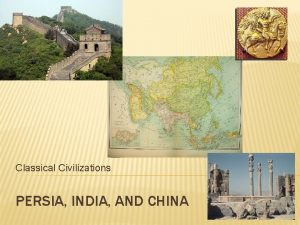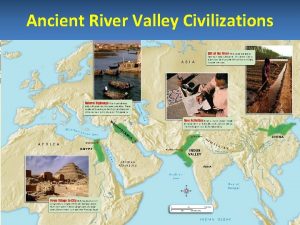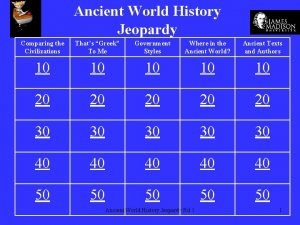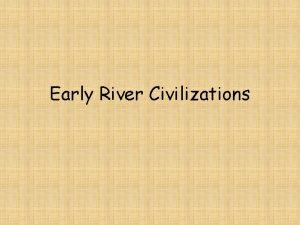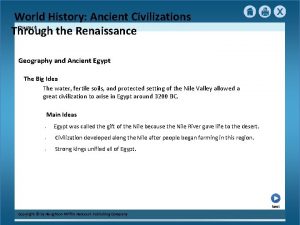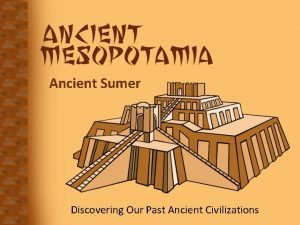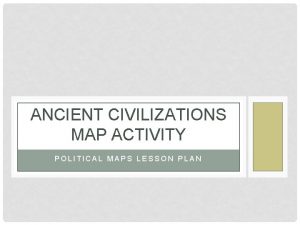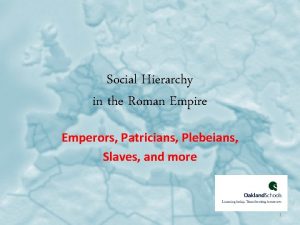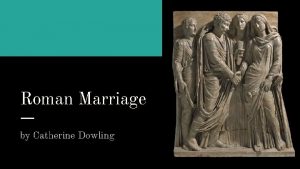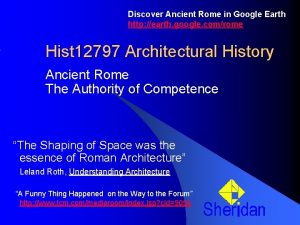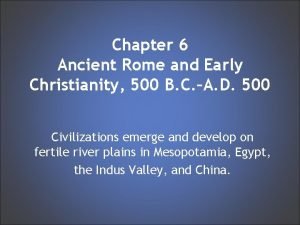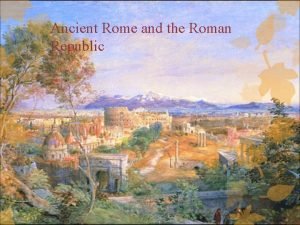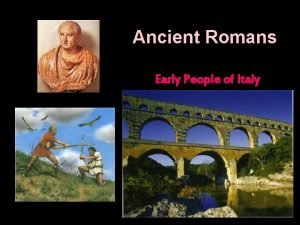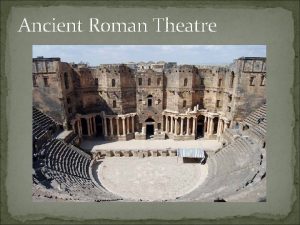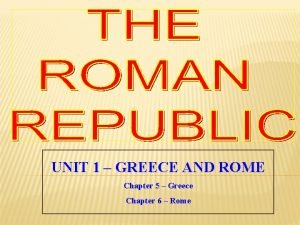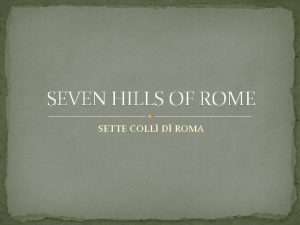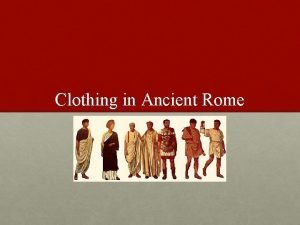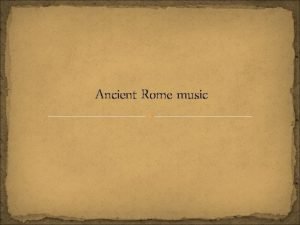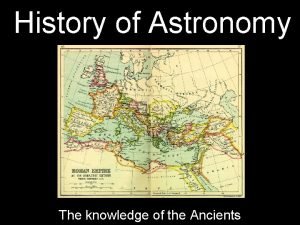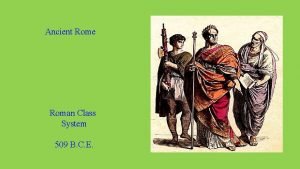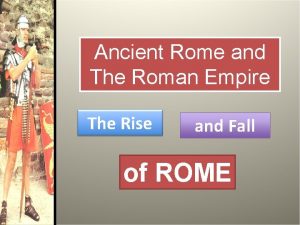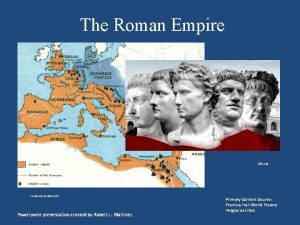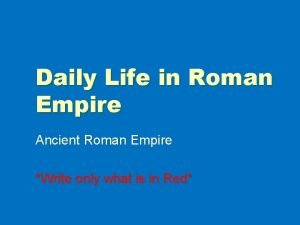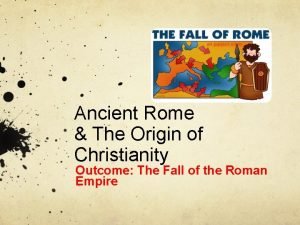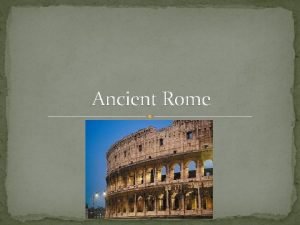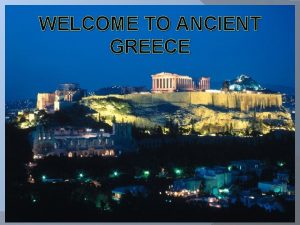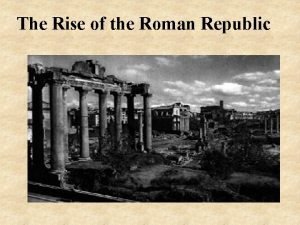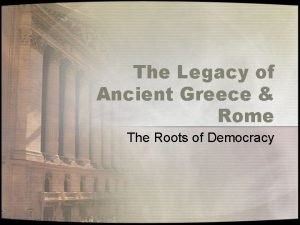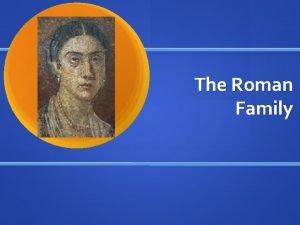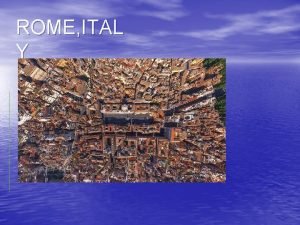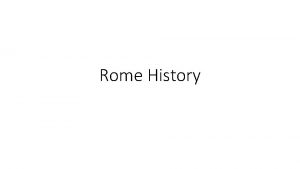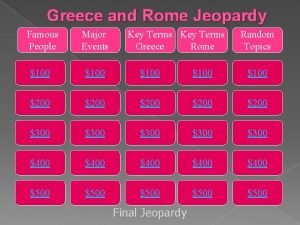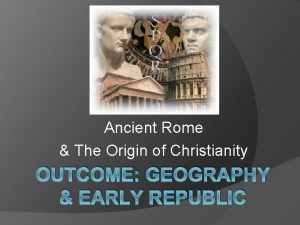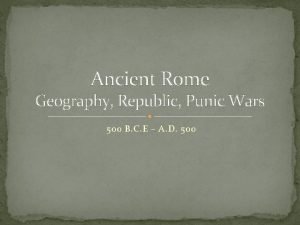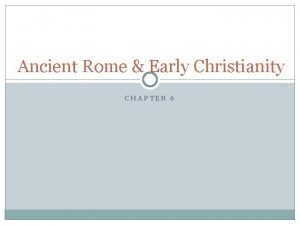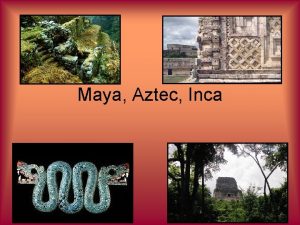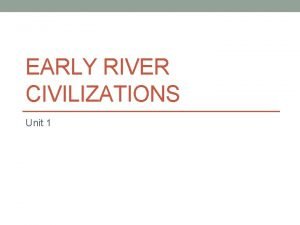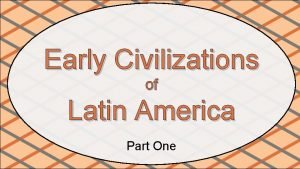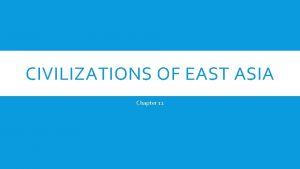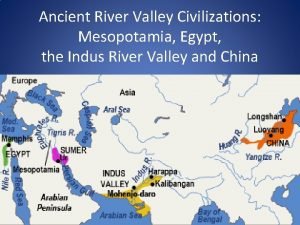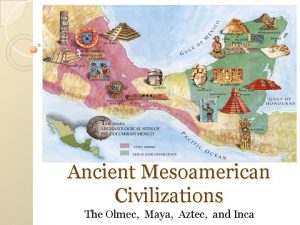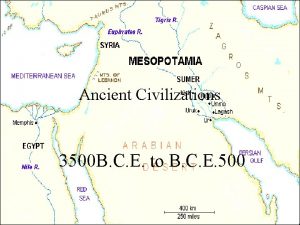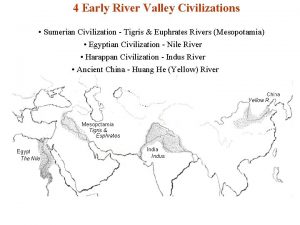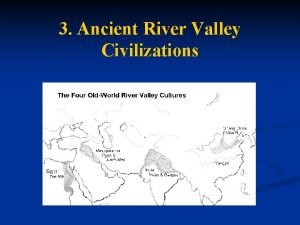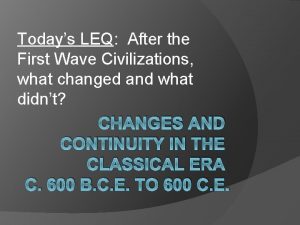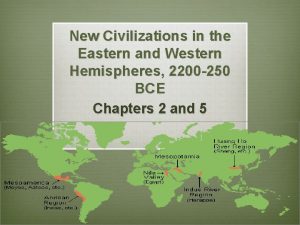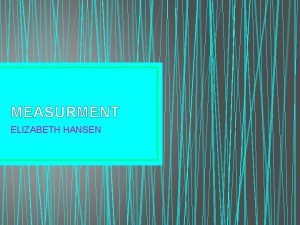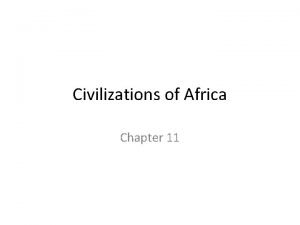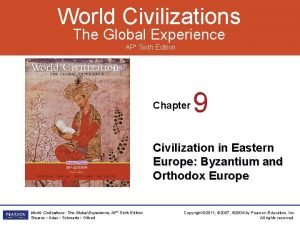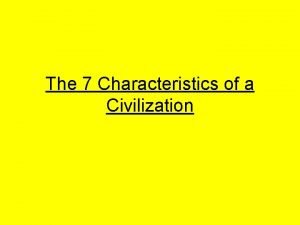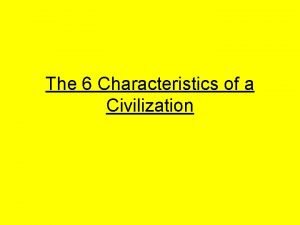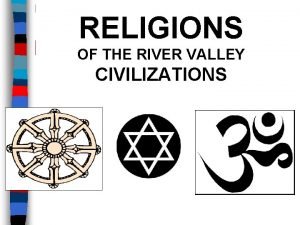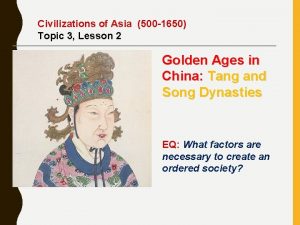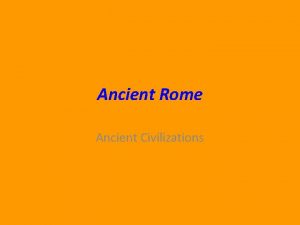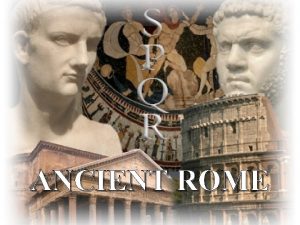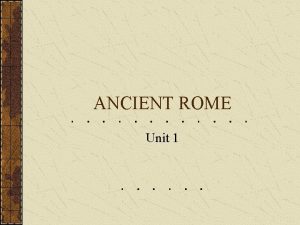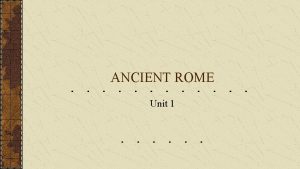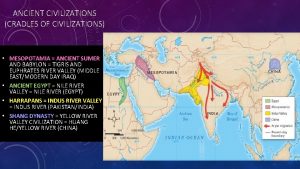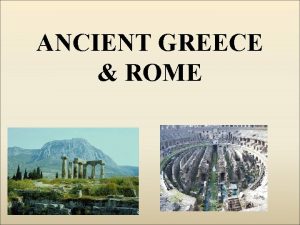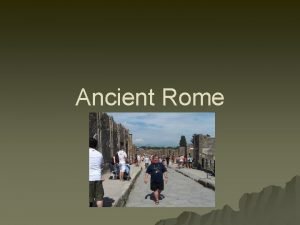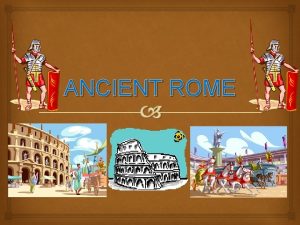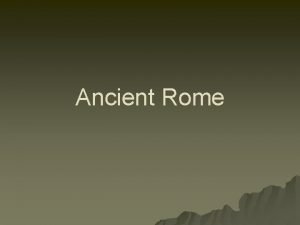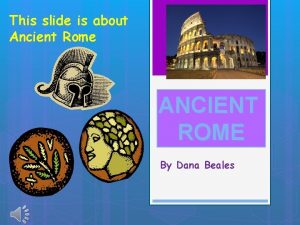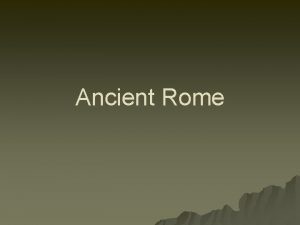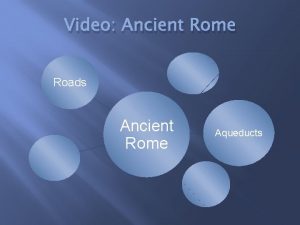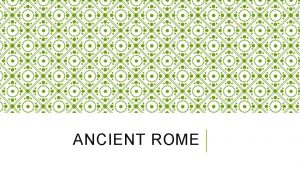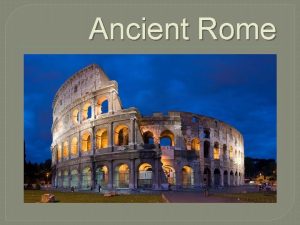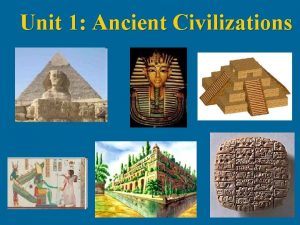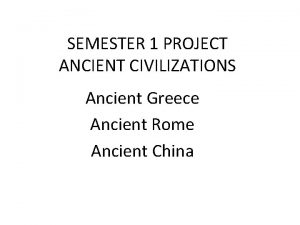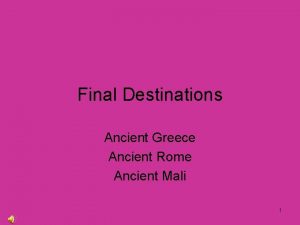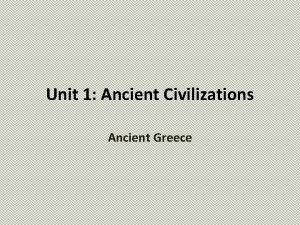Unit 1 Ancient Civilizations Ancient Rome Unit 1




























































- Slides: 60

Unit 1: Ancient Civilizations Ancient Rome

Unit 1: ROME The Roman World Takes Shape

Geography �Italian peninsula surrounded by water �Tiber River essential �Geography made unification easier �Mountains, not too rugged �Fertile land / supported pop �Rome by coast but center of Italy �Important for growth �Built on 7 hills


Roman Civilization Arises � 800 BC – Latins settled Tiber River �Small villages over 7 hills �Villages become Rome �Called city on 7 hills �Legend of Romulus & Remus �Twin brothers founded city �Sons of Latin woman & war god Mars

Roman Civilization Arises �Greeks in the south �Etruscans north of Rome �Ruled Rome/most of central Italy �Influenced by Etruscans �Adapted Etruscan alphabet taken from Greeks �Architecture (arch) �Engineering (drain marshy lands) �Merged Etruscan gods/goddesses w/theirs


Roman Republic � 753 -509: ruled by Etruscan kings � 509: end of Etruscan rule / estab of Roman state/republic �Lasts 500 years �Form of govt = republic: ppl choose officials �Individuals couldn’t get too powerful

Government Structure �Senate of 300; had most power early on �At first only patricians - landowners, ruling class �Every year 2 patricians nominated to be consuls – supervised govt & lead armies �Dictator chosen by Senate in event of war �Ruler who has complete control over govt �Could only rule for 6 months

Plebian Rights �Plebeians – most of pop: farmers, merchants, artisans, traders �Little say / few rights – fought for power �Got right to elect their own officials - tribunes �Could reject (veto) laws �Senate forced to + their power/role in govt

Growth of the Republic �Armies expand power �By 270 BC Rome controlled most of Italy �Roman Army: �Basic unit = legion (~ 5, 000 men) �Citizen soldiers �Big rewards, harsh punishments �Conquered ppl treadted fairly �Accept Roman leadership, pay taxes, supply soldiers �Keep customs, money, govt

Roman Society �Family = imp to society �Male = head & power �Wife = obey authority �Ideal woman = loving, dutiful, dignified, strong �women gain freedoms �Own prop, run businesses �Most = mother/homemaker �Boys/girls ed: reading/writing �Religion: �Polytheistic �Adapted from Greeks

Unit 1: Ancient Rome From Republic to Empire

Rome Grows �Began expands around Med Sea �Carthage – city state in N. Africa �Conflict btwn them – Punic Wars �Punic Wars – 3 wars btwn Rome & Carthage �Carthage led by military gen Hannibal � 1 st Punic War: �Rome wins & gains Sicily, Corsica, Sardinia

Rome Grows �Punic Wars cont… � 2 nd Punic War: �Hannibal led army/elephants over Alps to surprise attack Romans �Fighting. Carthage wanted revenge � led back to Carthage – Rome wins � 3 rd Punic War: �Carthage destroyed by Romans, ppl killed or made slaves �Rome dominated Med �Committed to imperialism – est control over foreign lands

Rome Grows �Conquest = trade & $ to Romans �Gap btwn rich/poor bigger �Wealthy grew & built latifundias & had slaves �Hurt farmers fled to Rome for work �Ppl rioting/protest greedy wealthy Romans / wanted reform �Tiberius & Gaius Gracchus – attempted reforms & angered Senate �Brothers & followers killed

Republic Declines �Civil wars over issues / who should hold power �Senate or pop leaders �Armies became loyal to their generals rather than Rome �Conflicts btwn armies �Julius Caesar: military leader/commander �Dominated with commander Pompey �Conquered Gaul

Republic Declines • Pompey betray Caesar / Caesar crushes Pompey �Forced senate to make him dictator �Ppl fearful he’d make himself king – they killed him �Ides of March (March 15 th) �Civil wars / fight for power after JC death �Marc Antony v. Octavian – Octavian wins becomes 1 st Emperor

Roman Empire Begins �Octavian given title Augustus �Stable govt set up �Kept senate / opened jobs to ppl regardless of class �Allowed self-govt �Economic reforms: �Took census (pop count), created postal service, new coins �Big issue was who would take over as emperor

Roman Empire �Many diff emperors after Augustus �Caligula & Nero = evil & insane �Series of “good emperors” �Hadrian – codified Roman law (made same everywhere) �Marcus Aurelius �Period of Pax Romana – 200 yr span - Augustus to Aurelius �Time of “Roman Peace” �Prosperity, unity, order, + trade, spread of ideas, entertainment

Roman Empire �Pax Romana cont… �Hidden/underlying social & econ problems �Entertainment & free grain used to hide probs from public/distract them �Chariot races, gladiator contests �Policy of “bread & circuses”

Unit 1: Ancient Rome The Roman Achievement

Roman Ideals & Civilization • Spread through conquest • Admired Greek arts/sciences • New civs blend Roman, Greek, & Hellenistic – Led to Greco-Roman civilization

Literature • Latin used by great Roman writers • Virgil – wrote epic poem Aeneid to show heroic Roman past & bring unity • Others wrote to satirize (make fun of) Roman society

History • Roman historians focused on rise & fall of Rome • Livy – build patriotism by focusing on heroic past • Tacitus – focused on downfalls of Roman past; thought rulers took Roman liberty

Philosophy • Barrowed a lot from Greeks • Hellenistic idea of stoicism – Influenced many – Ideas shown in later Christian teachings – Based on ethics/divine reason

Roman Art • Dev from Greeks & Etruscans • More expressive • Sculptures focused on character – Some idealistic • Artwork showed literature & daily life – Frescoes – Mosaics – pic from pieces of colored stone/glass

Roman Architecture • Dev from Greeks & Etruscans • Big impressive buildings - show power/ dignity – Palaces, temples, stadiums • Improved arches & columns • Used concrete • Dev rounded dome roof

Architecture Pantheon Colosseum

Science and Math • Engineering – science/math to create structures & machines – Roads, bridges, etc – Built aqueducts • Bridgelike stone structures - carried water from mountains to cities • Rich had water in homes • Bath houses


Science and Math • Ptolemy – astronomer; said Earth was center of universe – Stuck for 1500 years • Romans used science practically – maps

New Law Codes Protect the Empire • Big on rule of law & justice – Roman ideas basis for legal systems (US) • Civil law + law of nations – Fair laws applied equally to all ppl • • Innocent until proven guilty Punish for actions, not thoughts Guilt be est “clearer than daylight” Judges

Unit 1: Ancient Rome Christianity in the Empire

Early Empire �Pax Romana: “Roman Peace” ◦ Christianity dev �Official religion = Roman gods/goddesses ◦ Allowed others in conquered places �Ppl still had to show loyalty to Rome ◦ Honor Roman gods / acknowledge divine spirit emperor

Early Empire �Romans took Judea ~ 63 BC ◦ Most Jews lived here ◦ Excused them from worship �Divisions among Jews ◦ Zealots wouldn’t live under Roman rule �Zealots want own state & to revolt ◦ Believed a messiah (king sent by God) would come/lead them to freedom


Jews �AD 66: Jewish revolt in Jerusalem ◦ Crushed by Rome 4 yrs later �Romans destroyed Jewish temple/took Jerusalem �Jews fled Judea

Jesus & His Teachings �Jesus: Born in Bethlehem ~ 4 BC ◦ Jewish teacher / humility, charity, love and forgiveness ◦ The messiah; called “the Son of the Most High God” �Began preaching / recruited disciples (followers) to help ◦ 12 disciples / apostles

Jesus & His Teachings �Rooted in Jewish tradition ◦ 1 God / 10 Commandments �Seen as troublemaker by Jewish leaders & Roman officials ◦ Arrested & crucified ◦ Disciples spread his teachings

Christianity Spreads �Christians: Jesus = messiah = Christ �Ap. Peter est Christianity in city of Rome �Ap. Paul: most influential in spread ◦ Spread to gentiles (non-Jews) ◦ Believers / followers got salvation (eternal life)

Persecution �religion & persecution grew �Rome feared Christians had higher loyalty �Nero (54 -68 AD) heavy persecution, fighting in Colosseum, scapegoats ◦ Martyrs – Christians killed – ppl who suffer/die for beliefs

Message & Acceptance �Religion spread despite persecution ◦ Missionaries used Greek philosophy to appeal to educated Romans ◦ Unity of Roman empire helped �Persecution ends 313 AD with emperor Constantine

Constantine �Ruler beginning in 313 �After winning issued the Edict of Milan: freedom of worship to all citizens of the Roman Empire

Theodosius �In 392 AD, forbade all religions other than Christianity ◦ Made Christianity official religion of Roman empire

Early Christian Church �Ppl had to be baptized to join church ◦ Blessed with holy water �Ppl gathered Sundays for ceremony of thanksgiving to God ◦ Eucharist – sacred rite where baptized ate bread & drank wine in memory of Jesus �Clergy – grp of ppl who conducted Christian services ◦ Only men

Early Christian Church �Diocese = clergy and Christian community ◦ Each diocese had own priest �Bishop – high Church official responsible for those in his diocese – presided over priest �Bishops of most important cities gained greater authority ◦ Called patriarchs – authority over other bishops

Church Hierarchy �Church developed hierarchy ◦ Rivalry developed �Bishops of Rome called = popes ◦ Started to claim authority over all others �Heresies – beliefs that differ from official Church teachings – caused divisions �Scholars of early Church ◦ Augustine – bishop in N. Africa


Unit 1: Ancient Rome The Decline and Fall of Rome

Division of the Empire � Political & economic probs after Pax Romana � Political Violence & Instability: › Emperors overthrown by power hungry ppl or military gens; cycle of power & assass › 26 emperors in 50 yrs

Division of the Empire � Social & Economic Problems: › High taxes › Farmers left land for protec and lived on large estates �Worked for landowners / farmed small personal plots � Emperor Diocletian wanted to restore order (284) › Divided empire into 2 parts (east/west) › He controlled east; co-emperor Maximian west

Division of the Empire

Division of the Empire � Diocletian fixed prices to slow inflation – rapid rise of prices � Rules to ensure steady food production � 312 – Constantine takes throne › Continued reforms › Est new capital, “New Rome” at Constantinople; eastern empire center of power � Reforms only temporary fix

Invaders � Migrating Nomads: › Huns – nomadic ppl of East Asia – migrated to eastern Europe ~ 370 (leader = Attila) �Fought Germanic ppls along the way �Germanic ppl fled to Roman territory for safety › Rome couldn’t keep invaders out; surrendered parts of emp & eventually Rome itself

Invaders � Rome sacked by Visigoths in 410 � Germanic grps took over much of western empire � 434 – Attila (the “scourge of God”) set out for conquest across Europe � 476 – Germanic leader Odoacer ousted Roman emperor › Referred to as the “fall” of Rome

Invaders

Problems/Causes � Military Attacks › Most obvious = invasions › Roman soldiers weaker; mercenaries hired (foreign soldiers serving for pay) �Little to no loyalty to Rome � Political Turmoil › Govt lost support of the ppl; Corrupt officials › Division of Rome while under attack = bad idea

Problems/Causes � Economic Weaknesses › Heavy taxes; reliance on slave labor › Middle class into poverty; population declined � Social Decay › Decline in Roman values (patriotism, discipline, loyalty) › Upper class care only about themselves

The End of Rome? ? ? � Eastern part of Roman empire existed for another 1, 000 yrs › The Byzantine empire � Roman civilization survived › Under new rule � Germanic ways eventually took over � Christian Church kept aspects of Roman civ
 Ancient river valley civilizations map
Ancient river valley civilizations map Ancient india lesson 1 early civilizations
Ancient india lesson 1 early civilizations What is it
What is it Civilization ppt template
Civilization ppt template Ap world jeopardy
Ap world jeopardy Ancient civilizations of the old world map
Ancient civilizations of the old world map World history ancient civilizations through the renaissance
World history ancient civilizations through the renaissance Discovering our past ancient civilizations
Discovering our past ancient civilizations Four corners of civilization map
Four corners of civilization map Romans social structure
Romans social structure Dowry ancient rome
Dowry ancient rome Ancient google earth
Ancient google earth Chapter 6 ancient rome and early christianity
Chapter 6 ancient rome and early christianity Ancient rome geography
Ancient rome geography The etruscans lived in the area known as _____.
The etruscans lived in the area known as _____. History of theatre ancient rome
History of theatre ancient rome Ancient rome tiber river
Ancient rome tiber river What are the names of the seven hills of rome
What are the names of the seven hills of rome Ave magister
Ave magister Clothing in ancient rome
Clothing in ancient rome Ancient rome dance
Ancient rome dance Byzantine empire facts
Byzantine empire facts Importance of spartan education
Importance of spartan education Astronomy in ancient rome
Astronomy in ancient rome Rome social structure
Rome social structure Ancient rome: the rise and fall of an empire cast
Ancient rome: the rise and fall of an empire cast Pbs roman emperors
Pbs roman emperors Daily life roman empire
Daily life roman empire Ancient rome and the origins of christianity
Ancient rome and the origins of christianity Famous rome landmarks
Famous rome landmarks Patricians of ancient rome
Patricians of ancient rome Abcs of greece
Abcs of greece Patricians ancient rome
Patricians ancient rome The legacy of ancient greece and rome
The legacy of ancient greece and rome Roman empire family life
Roman empire family life Physical geography of rome
Physical geography of rome Cultural diffusion in rome
Cultural diffusion in rome Ancient rome jeopardy
Ancient rome jeopardy Ancient rome outcomes geography and early republic
Ancient rome outcomes geography and early republic Carthage geography
Carthage geography Chapter 6 ancient rome and early christianity
Chapter 6 ancient rome and early christianity Maya aztec and inca map
Maya aztec and inca map Ancient river valleys map
Ancient river valleys map Inca diorama
Inca diorama Chapter 11 civilizations of east asia
Chapter 11 civilizations of east asia 4 river valley civilizations
4 river valley civilizations Mayan vs aztec vs inca timeline
Mayan vs aztec vs inca timeline 3500bce
3500bce 4 river valley civilizations
4 river valley civilizations River valley civilizations definition
River valley civilizations definition Second wave civilizations
Second wave civilizations Mediterranean civilizations location hemisphere
Mediterranean civilizations location hemisphere Which civilizations were the first to record measurements
Which civilizations were the first to record measurements Chapter 11 section 1 early civilizations of africa
Chapter 11 section 1 early civilizations of africa Native american cultural areas
Native american cultural areas World civilizations the global experience ap edition
World civilizations the global experience ap edition World civilizations the global experience 7th edition
World civilizations the global experience 7th edition The 7 characteristics of a civilization
The 7 characteristics of a civilization Explain the characteristics of a civilization
Explain the characteristics of a civilization River valley civilizations religion
River valley civilizations religion Topic 3 review questions civilizations of asia answers
Topic 3 review questions civilizations of asia answers


